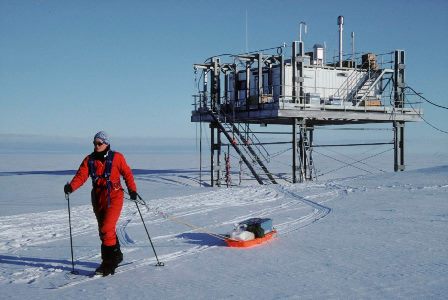Clean Air Sector Laboraotry (CASLab)

The Clean Air Sector Laboratory (CASLab) was commissioned in 2003 at Halley V station (75°35′S, 26°34′W).It operated successfully for five years before a temporary suspension during the construction of the new Halley VI station. In January 2012, the CASLab was installed at its new location at Halley VI (75°35′S, 26°10′W). The new site is some 20km from Halley V, and has effectively identical environmental conditions.
CASLab is a specialised observatory dedicated to studies of this remote background atmosphere and the processes that influence its chemical signature. It contains a suite of instruments to measure the chemistry of the clean air and the snow surface around Halley.
The laboratory supports short-timescale studies to determine and quantify controlling processes, and long-term observations to monitor for compositional change.
Halley is a ‘Global’ station within the World Meteorological Organisation Global Atmospheric Watch Programme, providing critical baseline observations of atmospheric composition to the international community. Since 1983, Halley station has contributed to the NOAA cooperative sampling network.
The Halley CASLab is operated by the British Antarctic Survey but with a view to work collaboratively with research groups in the UK or international science community.
Location
The CASLab is located close to the Weddell Sea coast. As the coast effectively forms a promontory at this point, the CASLab is exposed to the Weddell Sea in three directions. The surrounding area is flat and snow-covered with the nearest rock outcrops roughly 200km away.
The CASLab sits approximately 30 metres above sea level on the floating Brunt Ice shelf in the Atlantic sector of coastal Antarctica.
The CASLab is situated 1km from the station generators, in a clean air sector that receives minimal contamination from the base.
Access to the laboratory is on foot or by ski. Vehicle access is limited to a few occasions each year for delivery of equipment.
Climate
During the summer months, an open water lead, that can be several tens of kilometres wide, extends along the ice front. During the winter, open water leads form regularly when the prevailing easterly winds force sea ice offshore.
In particular, Precious Bay, to the south-west of Halley, is normally ice-free during winter and spring such that air arriving at Halley from this direction (the secondary wind-rose maximum) is likely to have had contact with open water.
Wind speeds at Halley vary considerably through the year from very calm conditions to storms (mainly in winter/spring) gusting to 25 ms-1. Annual temperatures range from just below 0°C in summer to around −45°C in winter.
The laboratory is constructed from three x 20ft shipping containers and mounted on a steel, legged platform. The platform is raised approximately every two years to maintain its height above the snow surface. This is necessary because of the amount of snow accumulation at Halley.
Inlets
The CASLab has dedicated inlet stacks for trace gas and for aerosol sampling which are roughly eight metres above the snow surface.
Trace gas inlet stack
The trace gas inlet stack comprises a 100mm internal diameter (i.d.) electropolished stainless steel tube ventilated by a fan at the far end (see diagram below). The air flow through this central stack is ∼314 m³/hour, giving a residence time within the stack of less than 1 second. Samplers drawing from the stack remove only a small percentage of the total air flow. Access to the air flow is achieved via individual 1/4″ stainless steel tubing ports that penetrate to the centre of the air flow.
Aerosol inlet stack
The aerosol inlet stack comprises a 200 mm i.d. stainless steel chimney with a cowl at the air intake to prevent snow ingress (see diagram below). Ventilation is achieved using a fan with a variable flow rate. The flow rate can be altered according to the volume of air being drawn from the stack by samplers, thus enabling isokinetic sampling.
Each sampler accesses the stack via stainless steel cones installed at the base of the chimney (see Figs A and B below). The area of each cone is specific to a particular sampler’s flow rate, thus maintaining isokinetic flow up to the point of sampling (see Fig A below). Samplers connect to the cones via swagelock connectors.
Gland plates
There are various locations in the walls and ceiling of the laboratory where gland plates allow penetration to the outside world. For equipment that cannot sample from the inlet stacks, dedicated inlets can be passed through the laboratory structure to equipment inside.
Power supply
Electricity in the CASLab runs at 240V, but a second circuit is available at 110V.
Compressed gas cylinders
There are two gas stores on the CASLab, one for flammable and one for non-flammable gases. A comprehensive gas distribution system exists for delivering gases to instruments in the laboratory.
Aerosol sampling
The CASLab is equipped with both high-volume and low-volume aerosol sampling equipment as well as a cascade impactor. Filter changes are done in a clean area of the lab under a laminar flow hood.
Instrument storage
There is space in the laboratory for instruments to be either rack-mounted or bench-mounted.
Wet chemistry
There is no running water at the CASLab, but any associated wet chemistry can be carried out at the wet chemistry laboratory on the main station platform. A supply of MilliQ water is available in the wet chemistry lab. Any solutions required for instrumentation can be brought to the CASLab on a sledge.